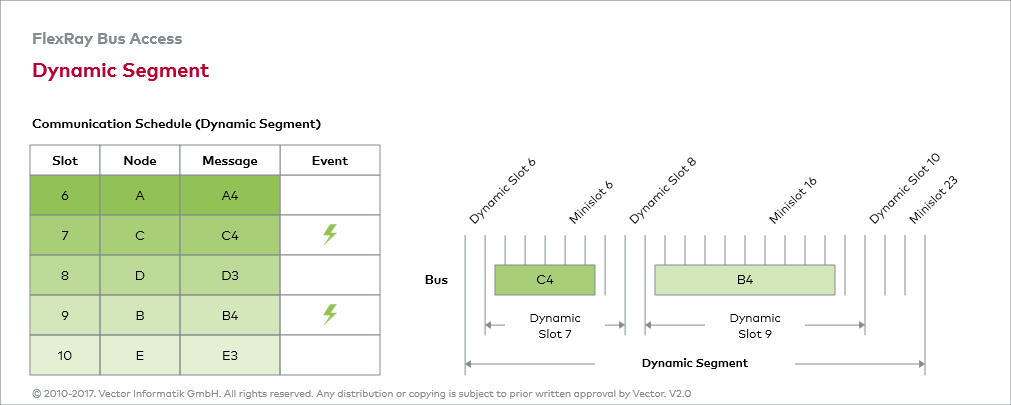Dynamic Segment
The dynamic segment is optional. It serves to transmit event driven messages and thereby supports asynchronous processes. To avoid affecting the deterministic data transmission of the static segment, the dynamic time segment always exhibits the same length. The dynamic time segment, if it is implemented, always follows the static segment.
The dynamic segment is based on the FTDMA method (Flexible Time Division Multiple Access), whose core is indeed the TDMA method. Despite this, it enables flexible communication flow. Therefore, communication in the dynamic segment is also based on a communication schedule. The dynamic messages defined in it are only transmitted in the dynamic segment if an event occurs which requires a message transmission.
The dynamic segment begins with all FlexRay nodes incrementing their local counters. The counter value refers to a specific dynamic message and FlexRay node. If there is no send request by the FlexRay node for the dynamic message matching the counter value, the FlexRay nodes increment their counters by the length of one minislot. In this case, the dynamic slot is exactly one minislot long.
On the other hand, if there is a send request, the relevant FlexRay node transmits the dynamic message matching the counter value. Following the dynamic slot is another minislot, which causes the FlexRay nodes to increment their counters. If there is a send request for the new counter value, the dynamic message matching the counter value is transmitted. If this is not the case, the next minislot follows immediately.
This procedure is repeated until the dynamic segment is no longer sufficiently long to transmit a dynamic message. In this case, no data transmission occurs until the end of the dynamic segment. Essentially, the next cycle is available for dynamic messages that have not been transmitted. An interactive figure is provided for a better understanding of data transmission in the dynamic segment. Read the instructions so that you can fully utilize its entire functionality.
Clearly, there is a relationship between the counter value that is assigned to a dynamic message and the probability that it will be transmitted: the higher the counter value, the less likely it is that a message will be transmitted. It may be concluded that the message assigned to the first minislot of the dynamic segment or the lowest counter value has the highest priority.
In the end, it is the system designer who must ensure that dynamic messages with lower priority can be transmitted – at least if no other needs with higher priority exist. The system designer must ensure that it will be possible to transmit the longest dynamic message.

